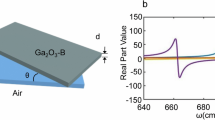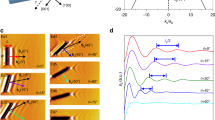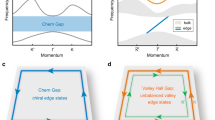Abstract
Topological photonics offers the opportunity to control light propagation in a way that is robust from fabrication disorders and imperfections. However, experimental demonstrations have remained on the order of the vacuum wavelength. Theoretical proposals have shown topological edge states that can propagate robustly while embracing deep subwavelength confinement that defies diffraction limits. Here we show the experimental proof of these deep subwavelength topological edge states by implementing periodic modulation of hyperbolic phonon polaritons within a van der Waals heterostructure composed of isotopically pure hexagonal boron nitride flakes on patterned gold films. The topological edge state is confined in a subdiffraction volume of 0.021 µm3, which is four orders of magnitude smaller than the free-space excitation wavelength volume used to probe the system, while maintaining the resonance quality factor above 100. This finding can be directly extended to and hybridized with other van der Waals materials to broadened operational frequency ranges, streamline integration of diverse polaritonic materials, and compatibility with electronic and excitonic systems.
This is a preview of subscription content, access via your institution
Access options
Access Nature and 54 other Nature Portfolio journals
Get Nature+, our best-value online-access subscription
$32.99 / 30 days
cancel any time
Subscribe to this journal
Receive 12 print issues and online access
$259.00 per year
only $21.58 per issue
Buy this article
- Purchase on SpringerLink
- Instant access to full article PDF
Prices may be subject to local taxes which are calculated during checkout



Similar content being viewed by others
Data availability
The near-field raw experimental data that support the findings of this study are available via Zenodo at https://doi.org/10.5281/zenodo.11992364 (ref. 50).
References
Xia, Y. et al. Observation of a large-gap topological-insulator class with a single Dirac cone on the surface. Nat. Phys. 5, 398–402 (2009).
Qi, X.-L. & Zhang, S.-C. Topological insulators and superconductors. Rev. Mod. Phys. 83, 1057–1110 (2011).
von Klitzing, K. The quantized Hall effect. Rev. Mod. Phys. 58, 519–531 (1986).
Su, W. P., Schrieffer, J. R. & Heeger, A. J. Soliton excitations in polyacetylene. Phys. Rev. B 22, 2099–2111 (1980).
Kim, M., Jacob, Z. & Rho, J. Recent advances in 2D, 3D and higher-order topological photonics. Light Sci. Appl. 9, 130 (2020).
Khanikaev, A. B. & Shvets, G. Two-dimensional topological photonics. Nat. Photonics 11, 763–773 (2017).
Smirnova, D., Leykam, D., Chong, Y. & Kivshar, Y. Nonlinear topological photonics. Appl. Phys. Rev. 7, 021306 (2020).
Haldane, F. D. M. & Raghu, S. Possible realization of directional optical waveguides in photonic crystals with broken time-reversal symmetry. Phys. Rev. Lett. 100, 013904 (2008).
Hafezi, M., Mittal, S., Fan, J., Migdall, A. & Taylor, J. M. Imaging topological edge states in silicon photonics. Nat. Photonics 7, 1001–1005 (2013).
Hafezi, M., Demler, E. A., Lukin, M. D. & Taylor, J. M. Robust optical delay lines with topological protection. Nat. Phys. 7, 907–912 (2011).
Lu, L., Joannopoulos, J. D. & Soljačić, M. Topological photonics. Nat. Photonics 8, 821–829 (2014).
Rüter, C. E. et al. Observation of parity–time symmetry in optics. Nat. Phys. 6, 192–195 (2010).
Ozawa, T. et al. Topological photonics. Rev. Mod. Phys. 91, 015006 (2019).
Ota, Y. et al. Active topological photonics. Nanophotonics 9, 547–567 (2020).
Fang, K., Yu, Z. & Fan, S. Realizing effective magnetic field for photons by controlling the phase of dynamic modulation. Nat. Photonics 6, 782–787 (2012).
Rechtsman, M. C. et al. Photonic Floquet topological insulators. Nature 496, 196–200 (2013).
Khanikaev, A. B. et al. Photonic topological insulators. Nat. Mater. 12, 233–239 (2013).
Rider, M. S. et al. A perspective on topological nanophotonics: current status and future challenges. J. Appl. Phys. 125, 120901 (2019).
Lu, C.-C. et al. On-chip topological nanophotonic devices. Chip 1, 100025 (2022).
Rider, M. S. et al. Advances and prospects in topological nanoparticle photonics. ACS Photonics 9, 1483–1499 (2022).
Kim, M. & Rho, J. Topological edge and corner states in a two-dimensional photonic Su–Schrieffer–Heeger lattice. Nanophotonics 9, 3227–3234 (2020).
Cox, J. D. & García de Abajo, F. J. Nonlinear graphene nanoplasmonics. Acc. Chem. Res. 52, 2536–2547 (2019).
Rostami, H., Katsnelson, M. I. & Polini, M. Theory of plasmonic effects in nonlinear optics: the case of graphene. Phys. Rev. B 95, 035416 (2017).
Hendry, E., Hale, P. J., Moger, J., Savchenko, A. K. & Mikhailov, S. A. Coherent nonlinear optical response of graphene. Phys. Rev. Lett. 105, 097401 (2010).
Kumar, N. et al. Third harmonic generation in graphene and few-layer graphite films. Phys. Rev. B 87, 121406 (2013).
Lundeberg, M. B. et al. Tuning quantum nonlocal effects in graphene plasmonics. Science 357, 187–191 (2017).
Boroviks, S. et al. Extremely confined gap plasmon modes: when nonlocality matters. Nat. Commun. 13, 3105 (2022).
Yang, Y. et al. A general theoretical and experimental framework for nanoscale electromagnetism. Nature 576, 248–252 (2019).
Sinev, I. S. et al. Mapping plasmonic topological states at the nanoscale. Nanoscale 7, 11904–11908 (2015).
Yan, Q. et al. Near-field imaging and time-domain dynamics of photonic topological edge states in plasmonic nanochains. Nano Lett. 21, 9270–9278 (2021).
Moritake, Y., Ono, M. & Notomi, M. Far-field optical imaging of topological edge states in zigzag plasmonic chains. Nanophotonics 11, 2183–2189 (2022).
Ju, L. et al. Graphene plasmonics for tunable terahertz metamaterials. Nat. Nanotechnol. 6, 630–634 (2011).
Fei, Z. et al. Infrared nanoscopy of dirac plasmons at the graphene–SiO2 interface. Nano Lett. 11, 4701–4705 (2011).
Woessner, A. et al. Highly confined low-loss plasmons in graphene–boron nitride heterostructures. Nat. Mater. 14, 421–425 (2015).
Ni, G. X. et al. Fundamental limits to graphene plasmonics. Nature 557, 530–533 (2018).
Xiong, L. et al. Photonic crystal for graphene plasmons. Nat. Commun. 10, 4780 (2019).
Caldwell, J. D. et al. Photonics with hexagonal boron nitride. Nat. Rev. Mater. 4, 552–567 (2019).
Dai, S. et al. Tunable phonon polaritons in atomically thin van der waals crystals of boron nitride. Science 343, 1125–1129 (2014).
Caldwell, J. D. et al. Sub-diffractional volume-confined polaritons in the natural hyperbolic material hexagonal boron nitride. Nat. Commun. 5, 5221 (2014).
Lee, I.-H. H. et al. Image polaritons in boron nitride for extreme polariton confinement with low losses. Nat. Commun. 11, 3649 (2020).
Lee, D. et al. Hyperbolic metamaterials: fusing artificial structures to natural 2D materials. eLight 2, 1 (2022).
Giles, A. J. et al. Ultralow-loss polaritons in isotopically pure boron nitride. Nat. Mater. 17, 134–139 (2018).
Herzig Sheinfux, H. et al. High-quality nanocavities through multimodal confinement of hyperbolic polaritons in hexagonal boron nitride. Nat. Mater. 23, 499–505 (2024).
Sheinfux, H. H. et al. Transverse hypercrystals formed by periodically modulated phonon-polaritons. ACS Nano 17, 7377–7383 (2023).
Rappoport, T. G., Bludov, Y. V., Koppens, F. H. L. & Peres, N. M. R. Topological graphene plasmons in a plasmonic realization of the Su–Schrieffer–Heeger model. ACS Photonics 8, 1817–1823 (2021).
Xiao, M., Zhang, Z. Q. & Chan, C. T. Surface impedance and bulk band geometric phases in one-dimensional systems. Phys. Rev. X 4, 021017 (2014).
Geim, A. K. & Grigorieva, I. V. Van der Waals heterostructures. Nature 499, 419–425 (2013).
Richards, D., Zayats, A., Keilmann, F. & Hillenbrand, R. Near-field microscopy by elastic light scattering from a tip. Philos. Trans. R. Soc. Lond. Ser. Math. Phys. Eng. Sci. 362, 787–805 (2004).
Orsini, L., Torre, I., Herzig-Sheinfux, H. & Koppens, F. H. L. Quantitative scattering theory of near-field response for 1D polaritonic structures. Preprint at https://arxiv.org/abs/2307.11512v1 (2023).
Orsini, L. Near-field experimental dataset for the Article “Deep Subwavelength Topological Edge State in a Hyperbolic Medium”. Zenodo https://doi.org/10.5281/zenodo.11992364 (2024).
Acknowledgements
F.H.L.K. acknowledges support by the ERC TOPONANOP under grant agreement no. 726001, the Gordon and Betty Moore Foundation through Grant GBMF12212, project GRAFENOG, the Government of Spain (PID2019-106875GB-100; Severo Ochoa CEX2019-000910-S (MCIN/ AEI/10.13039/501100011033), PCI2021-122020-2A and PDC2022-133844-100 funded by MCIN/AEI/10.13039/501100011033), the European Union NextGenerationEU/PRTR (PRTR-C17.I1) and EXQIRAL 101131579, Fundació Cellex, Fundació Mir-Puig and Generalitat de Catalunya (CERCA, AGAUR, 2021 SGR 01443). Views and opinions expressed are, however, those of the author(s) only and do not necessarily reflect those of the European Union Research Executive Agency. Neither the European Union nor the granting authority can be held responsible for them. Furthermore, the research leading to these results has received funding from the European Union’s Horizon 2020 under grant agreement no. 881603 (Graphene flagship Core3) and 820378 (Quantum flagship). This material is based upon work supported by the Air Force Office of Scientific Research under award number FA8655-23-1-7047. Any opinions, findings, and conclusions or recommendations expressed in this material are those of the author(s) and do not necessarily reflect the views of the United States Air Force. L.O. acknowledges support by The Secretaria d’Universitats i Recerca del Departament d’Empresa i Coneixement de la Generalitat de Catalunya, as well as the European Social Fund (L’FSE inverteix en el teu futur)—FEDER. G.M.A. acknowledge funding from the European Research Council (ERC) under the European Union’s Horizon 2020 research and innovation programme (grant agreement no. 101002955 – CONQUER). S.L. acknowledges the National Research Foundation of Korea (NRF) grant funded by the Korean government (MSIT) (grant no. NRF-2023R1A2C1007836 and NRF-2020R1C1C1012138). J.H.E. and E.J. acknowledge the support for hBN crystals growth coming from the Office of Naval Research, award number N00014-22-1-2582. O.S. acknowledges the support of the Engineering and Physical Sciences Research Council (grant number EP/W005484). For the purpose of open access, the author has applied a Creative Commons Attribution (CC BY) licence to any Author Accepted Manuscript version arising. H.H.S. acknowledges funding from the European Union’s Horizon 2020 programme under the Marie Skłodowska-Curie grant agreement ref. 456 843830. M.C. acknowledges the support of the ‘Presencia de la Agencia Estatal de Investigación’ within the ‘Convocatoria de tramitación anticipada, correspondente al año 2020, de las ayudas para contractos predoctorales (ref. PRE2020-XXXXXX) para la formación de doctores contemplada en el Subprograma Estatal de Fromación del Programa Estatal de Promoción del Talento y su Empleabilidad en I + D + i, en el marco del Plan Estatal de Investigacón Científica y Técnica de Innovación 2017-2020, cofinanciado por el Fondo Social Europeo’. K.S. acknowledges the support from the European Commission in the Horizon 2020 Framework Programme under grant agreement nos. 785219 (Core2) and 881603 (Core3) of the Graphene Flagship. G.S. and Y.L. acknowledge the support of the Office of Naval Research (grant no. N00014-21-1-2056), the Army Research Office (grant no. W911NF-21-1-0180) and the National Science Foundation MRSEC programme (grant no. DMR-1719875).
Author information
Authors and Affiliations
Contributions
L.O. and H.H.S. worked on sample fabrication with help from M.C. and K.S. Isotopic hBN crystals were grown by E.J. and J.H.E. Measurements and data analysis were performed by L.O. Simulations were performed by L.O. with help from Y.L. Theoretical support was provided by O.S., G.M.A., Y.L., S.L. and H.H.S. Experiments were designed by L.O., H.H.S and F.H.L.K. All authors contributed to writing the manuscript, and G.S. and F.H.L.K supervised the work.
Corresponding author
Ethics declarations
Competing interests
The authors declare no competing interests.
Peer review
Peer review information
Nature Nanotechnology thanks Junsuk Rho and the other, anonymous, reviewer(s) for their contribution to the peer review of this work.
Additional information
Publisher’s note Springer Nature remains neutral with regard to jurisdictional claims in published maps and institutional affiliations.
Supplementary information
Supplementary Information
Supplementary Discussion, Figs. 1–9 and Tables 1 and 2.
Rights and permissions
Springer Nature or its licensor (e.g. a society or other partner) holds exclusive rights to this article under a publishing agreement with the author(s) or other rightsholder(s); author self-archiving of the accepted manuscript version of this article is solely governed by the terms of such publishing agreement and applicable law.
About this article
Cite this article
Orsini, L., Herzig Sheinfux, H., Li, Y. et al. Deep subwavelength topological edge state in a hyperbolic medium. Nat. Nanotechnol. 19, 1485–1490 (2024). https://doi.org/10.1038/s41565-024-01737-8
Received:
Accepted:
Published:
Issue date:
DOI: https://doi.org/10.1038/s41565-024-01737-8
This article is cited by
-
Applications of ultrafast nano-spectroscopy and nano-imaging with tip-based microscopy
eLight (2025)
-
Boundary-induced excitation of higher-order hyperbolic phonon polaritons
Nature Photonics (2025)
-
Polaritonic Fourier crystal
Nature Communications (2025)
-
Nanoscale ultrafast camera unveils light-matter dynamics in real time and space
Light: Science & Applications (2025)
-
Revisiting hyperbolic materials for deep-subwavelength polaritonics
Nature Nanotechnology (2024)



